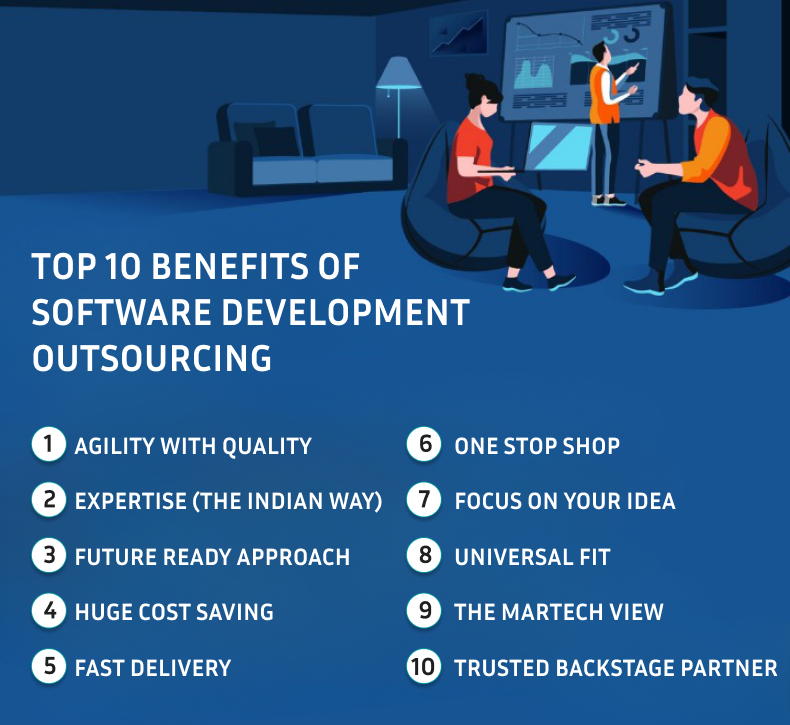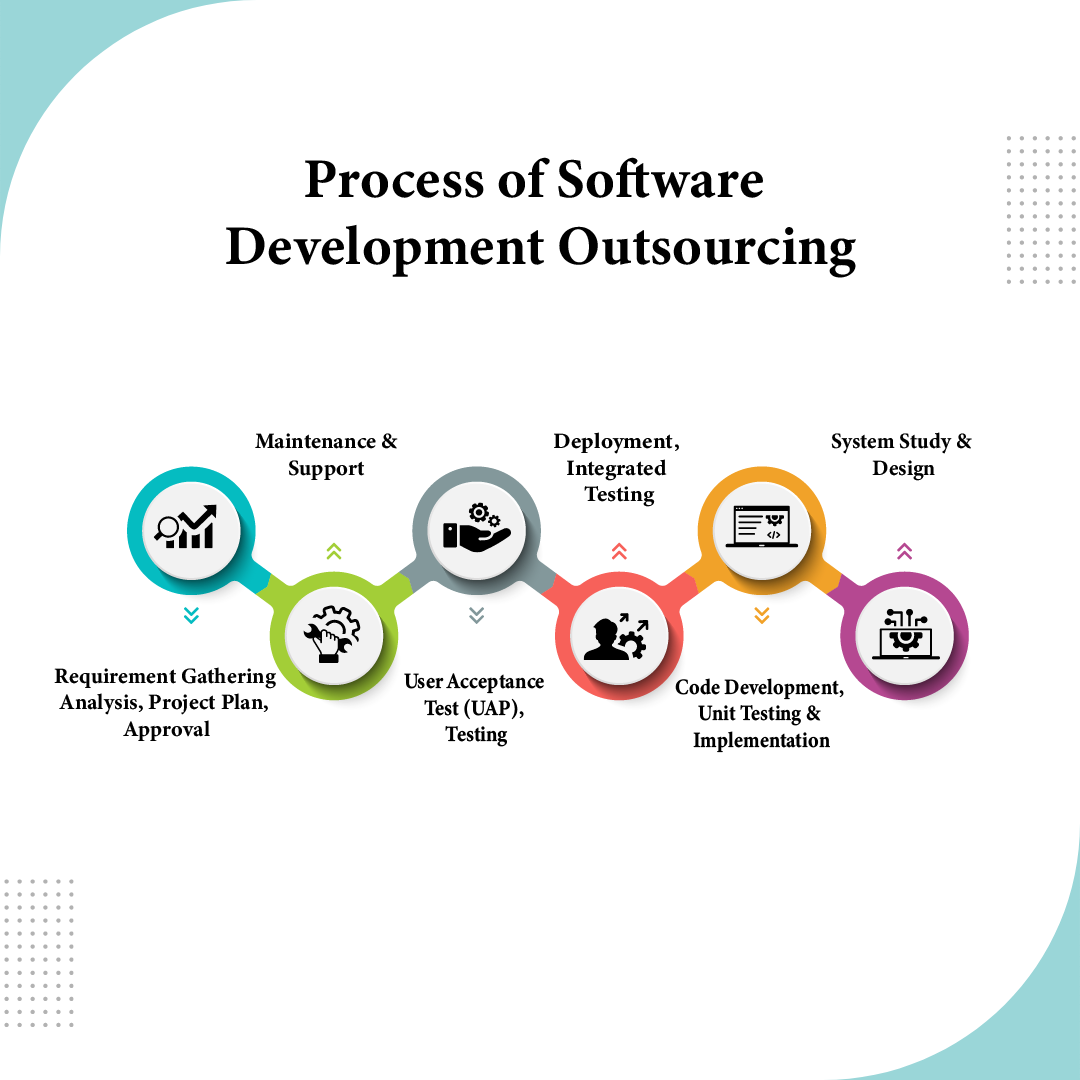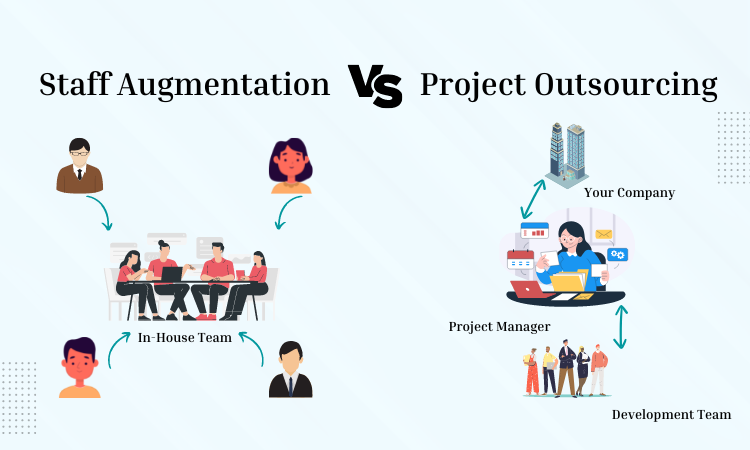
Here’s what you will learn:
Are you considering IT outsourcing services for your software development projects? Outsourcing software development is easiest way to reduce costs. And access talented developers without having to invest in an in-house team.
Moreover, here check out the statistics that represent that software and IT outsourcing services are savior in the current digital arena.
Subsequently, this blog post will provide an overview of what outsourcing IT services entails, how it works, and the potential benefits and challenges associated with it. We’ll also discuss how to choose the right software development team for your needs, and the key factors to consider when outsourcing.
By the end of this post, you will have a comprehensive understanding of what software development and IT outsourcing involves. And be able to make an informed decision about whether it’s the right choice for your business.
Table of Contents
What Are Software Development and IT Outsourcing Services?
Software and IT outsourcing is the process of contracting with a third-party vendor to develop or enhance software applications and other IT services. It allows organizations to access specialized expertise and advanced technologies from external providers that would otherwise be unavailable to them internally.
Using IT support outsourcing, organizations can benefit from lower costs, improved efficiency, and higher-quality end products. They are also able to benefit from flexible services delivery models, such as cloud-based solutions and on-demand services.
Outsourcing software development is often used to gain access to the latest technology trends, accelerate time-to-market, reduce operational costs, and meet the needs of customers. Additionally, it is often used to quickly develop and deploy custom applications. It can reduce the cost and complexity of managing multiple applications within an organization.
Why Do Businesses Need to Adopt IT Outsourcing Services?
Multiple factors affect businesses when they make the decision to outsource software development projects. In times past, many businesses never used outsourcing as a business practice at all—but that eventually changed with time. Companies were unaware of the potential benefits of doing so.
Cutting Down Costs
Money and time are two of the best reasons why many businesses decide to outsource. Instead of hiring full-time staff on payroll, investing in infrastructure, etc., outsourcing becomes a much more viable option for cutting expenses while improving profit margins.
Boosting Efficiency and Focus
With specialists handling different aspects of projects, there is never any question about familiarity or knowledge of technology. They just take up projects if they’re expert enough on them, which saves them from carrying around overhead expenses when not applicable.
Utilizing Flexible Solutions
Keeping up with changing dynamics in these new markets forces you to be agile – but also lets you drop irrelevant activities, so you don’t have an unreasonable overhead cost. With the ability to outsource services, you’ll be able to handle changes easily without having too much capital allocated elsewhere.
Leveraging a Global Talent Pool
It is often difficult to find qualified people within a city/state, let alone across borders. To gain access to international talent, outsourcing will be necessary for businesses. It allows them to hire remote developers, designers, and offshore workers who provide various services that can benefit the business greatly.
Saving Strategic Time
If you have an expert hired remotely for your business, then they free up most of the time spent on these important matters. And invest some value into other essential tasks such as designating whether specific skills need improvement; or developing new strategies to increase productivity.
Furthermore, this also enables CEOs/managers to focus on strategic decisions which could lead to greater productivity.
Building Productive Partnerships
Outsourcing helps partnerships grow through its higher efficiency, increased quality of products, and scalability of work environments provided by teams abroad.
Meeting customer expectation
Most of the time, it’s hard to meet customer expectations. But perhaps this is because businesses are struggling with so many other functions that hinder their ability to do so.
For example, Software Outsourcing firms help clients improve their rates for meeting customer expectation benchmarks using high-performing mobile apps.
Increasing and Scaling Productivity within Teams
Businesses have found success in hiring or even scaling up or down teams as needed through outsourcing services that cater to these specific needs.
Fulfilling New Consumer Demands
It’s not enough for businesses just to stick out one way when it comes to changing consumer demand–they also need an innovative solution if they want good results in reaching a broader market base.
Meanwhile, IT outsourcing services provide such insight, having cultivated experience working with clients across different locations. Simply, experience around the world with clients who demand change and versatility when working with vendors.
Being One Step Ahead of Competitors
Even though market disruptions threaten to disrupt everything you work so hard to build, they can also present a unique opportunity – one where you’re ahead of your competition.
Moreover, partnering with the right software development outsourcing partner will grant you a competitive advantage over other brands when it comes to staying innovative and sustainable.
If you want to know more, you can check out the blog on:
10 Reasons That Outsourcing IT Services Is Better Than Having an In-house Team
IT Outsourcing and Its Types
With more business-minded people on the planet, come new ideas and opportunities. With technology advancing at an ever-increasing rate, international trade has never been more beneficial to businesses trying to increase profit margins or look for work that isn’t available locally.
An IT outsourcing model can be classified depending on three criteria:
- location (nearshore versus offshore),
- relationship (staff augmentation vs managed team),
- and contract (outsourcing vs co-sourcing).
To outsourcing IT services, it’s important to understand the different types of engagements. Depending on how complicated it is, these engagements are categorized into three main categories:
Nearshore Outsourcing
Nearshore outsourcing is when geographical proximity and time zones are considered. Tasks or projects outsourced will be done by someone in the same region as you. For example, if a company is based in America, it’ll outsource its services to countries nearby like Mexico and Canada.
Countries close to one another make up this type of engagement because distance doesn’t matter much with this type of collaboration; Instead, what matters most is time zones because communication happens around the clock without having to worry about time differences when communicating.
The other advantage of nearshoring (as opposed to going offshore) is that everyone speaks the same language; altogether, follows similar standards for working practices; Moreover, there isn’t any culture clash involved either which makes it easy and straightforward collaboration between both parties.
Offshore Outsourcing
In offshore outsourcing, only portions of the work are outsourced to other countries. Ultimately it depends on how well this suits the company’s needs and optimizes its processes. This outsourcing model is beneficial for managing budgets while also hiring talent from a global pool with hourly rates or monthly fees.
Time zones often play an important role in remote working so there can be an advantage when conducting meetings over Skype and email where there are overlapping hours.
Onsite Outsourcing
This type of outsourcing means that the company in charge sends their experienced and skilled employees to provide services at a different company’s location. For example, if you are having difficulty getting enough customer service representatives who speak English fluently.
Or if you want an accounting firm to handle your tax preparation; Thus, you don’t have to hire someone from another country, then you can hire an outsourced company for these tasks instead.
Multi-shore Outsourcing
Multi-shore outsourcing is when a company employs many companies concurrently based on their location and services provided. This type of engagement model is safe and often used by large corporations; Because it caters to business needs that are serviced by nearshore and offshore partners.
Managed Team Outsourcing
In this model, the client hires a team that can be either onshore or off and manages their day-to-day development process. The in-house project manager communicates with the outsourced team; as well as assigns them tasks that are verified by in-house staff. Therefore, that key decision-making power remains with them.
Project-Based Outsourcing
In project-based models, the responsibility typically falls on the outsourcer and his ability to handle tasks. The outsourcer takes ownership of projects from start to finish-managing requirements and owning every minute detail right up until a project’s completion.
How to Choose the Right IT Outsourcing Company?
When it comes to outsourcing IT services, choosing the right partner can be a daunting task. There are many factors to consider, from the size and scope of the project to the type of technology used and the skills and experience of the team.
Here are some tips to help you choose the right outsourcing partner for your software development project:
- Know What You Need: Before engaging an outsourcing partner, take time to define the scope of your project and the desired outcomes. Clearly define the expected results and timeline so that the outsourcing partner can create a detailed plan for delivery.
- Research Potential Partners: When researching potential outsourcing partners, look for those with experience in developing similar projects. Ask for references and speak with other businesses to understand their experiences with the partner.
- Consider Cost and Value: While cost is an important factor in deciding on an outsourcing partner, focus on getting the most value for your money. Find out if they offer additional services such as project management or QA testing to help ensure quality results.
- Understand Their Processes: Make sure you understand the processes that your technology IT outsourcing partner uses when developing software. It will include their coding standards, version control, and bug tracking. This will help you ensure that your project is developed according to your specifications.
- Evaluate Communication Channels:Communication is key when it comes to outsourcing software development. Thus, make sure you have reliable channels for communication between you and the outsourcing partner. Establishing a clear process for communication upfront will help ensure that any issues are resolved quickly and efficiently.
By following these tips, you can be sure to select the right outsourcing partner for your software development project and get the best value for your money.
How Outsourcing Is Different from Staff Augmentation?
Software outsourcing and IT staff augmentation are two distinct concepts, but they are often confused. Both processes involve bringing in outside talent or services to help improve the quality of your technology operations, but they have key differences that are important to understand.
Software outsourcing is when a company contracts a third-party service provider or create software solutions from scratches, such as custom applications, databases, or systems. This allows businesses to access top-tier talent without having to hire an internal team, which can be expensive and time-consuming.
Despite, IT staff augmentation companiess bring in experienced IT professionals to work alongside your existing team. This can be beneficial if you need additional help with a specific project or short-term task, but don’t have the resources to hire a full-time employee.
The outside experts can quickly fill in any knowledge gaps and ensure the project is completed efficiently. When considering which option is right for your business, it’s important to weigh up the benefits and drawbacks of each approach.
Software outsourcing can be more cost-effective in the long run, as it eliminates the need for hiring. And training a new team, while IT staff augmentation is often better suited for shorter-term projects or specialized tasks.
No matter which routes you choose, both approaches are a great way to bring in external talent and expertise to help optimize your technology operations.
Software Development and IT Outsourcing Models
We’ll go over the three most used outsourcing models so you can see which one might work best for you.
#1. Time And Material Model
With this type of outsourcing model, you’re only looking at investment in resources based on hourly rates of labor. So, pricing usually happens in man-hours. And clients are billed on the number of hours spent on a specific project (plus the costs of materials). When is it appropriate to use a Time and material model?
- The project requires vague specifications or changes often.
- The scope is unknown or undefined from the beginning.
- It’s an experiment to test compatibility before taking any long-term commitments.
#2. The Dedicated Development Team Model
In this type of model, a team of developers, designers, QA testers, business analysts, and project managers are hired by the client. It happens from inside the company and acts as an extension of the client’s current team.
The client has full power to manage each one of these team members as if they were hiring remote employees themselves; but obviously, the cost will be higher in this model. When does it make sense to go for a dedicated development team model?
- If you decide on a very long-term strategic association with the outsourcing firm.
- If Software is your main competency and you need regular upkeep and upgrades.
#3. Fixed-Price Contract Model
It consists of end-to-end management of the entire software project within a preset cost, time frame, and scope. The fixed price model requires accurate knowledge of the project requirements and any significant deviation from required specification.
Those specifications will most likely result in additional costs for both parties involved. If you stay true to your end user agreement (and don’t change anything), there won’t be any surprises at the end of the day. Moreover, all costs have been clearly defined before they even began. When can you opt for a fixed-price contract?
- The project requirements are clear to both parties.
- There is little chance that there will be major changes in end-user agreements.
- Deadlines are set and agreed upon.
Major Challenges in IT Outsourcing
As stated above, the key benefit of outsourcing software development is the fact that you don’t need to hire people as full-time employees. Instead, you can rely on hiring contractors, which can significantly cut the costs of your project. However, you will still be signing contracts with your outsourcing partners.
But these IT Contracts are tricky; and if your legal department isn’t up to date with everything IT related. Let’s take a glance at five main areas where outsourcing contracts often cause problems.
#1. Jurisdiction matters
Since you and your contractor live in different parts of the world, by default you’ll each have a different competent court and governing law over you. You can decide which law system applies to your project in the contract.
Indeed, it may be convenient for you to leverage your countries’ rules. However, it is only possible if chosen IT outsourcing company agrees to it. You can choose one of these options if this aren’t favorable.
1) Your native country’s legal system – which is great when possible.
2) An unfamiliar yet mutually agreeable jurisdiction – like British law (which is currently very popular).
3) choose either yours or theirs with no preference given at all!
#2. Staff Organization
The contract you sign with your employees determines various aspects of their work, including transparency, the team’s size, and composition, as well as the notice period. These are the aspects you must specify to make sure that your project progresses just how you want it. This is also when accounting for staff rotation.
#3. Copyright
You need to make certain that the terms of the contract specify that you retain all rights to anything created for you. It is vital; however, you note if there are any components or libraries used by contractors, they will remain under an Open-Source license.
And when your project has been completed – otherwise, a piece of software created for you might end up being Open Source itself. For better outcomes, it is generally believed the best practice is to use suppliers’ own libraries. And component sets when possible, so long as they’re exclusively licensed for your needs.
#4. Source code and Object Code
Do yourself a favor, and make sure that your contract states you will be receiving the Source Code. You will then be able to modify the Object Code at your leisure. If you are legally considered the owner of your source code, it becomes easy to create backups.
#5. Documentation
Regardless of the size or scope of your project, documenting everything is key. There are two types of documentation you may need: technical documentation (to help developers understand how things work) and user-facing documentation (for end users).
Cost-effective Locations for IT Staffing & Outsourcing
Every business has its own unique need, which is why businesses often reach out to others for help – whether it’s close by or overseas. When it comes to offshore places, not every one of them will work well for everyone.
To make things easier for you, we’ve compiled a list of popular destinations across the world where you can find what you’re looking for.
#1. India
The Indian outsourcing market has millions of IT outsourcing companies and amazingly skilled employees. These people work at a fraction of what they would charge elsewhere. In terms of market space and types of technology, they’ve left no stone unturned.
They’ve been supplying all sorts of advanced services to businesses around the globe. The quantity of innovation in startups and large firms is increasing in India—it’s commendable with reliability and quality service.
Typical hourly rates range from $15-$65, depending on the size of the company partnered with. Major software outsourcing locations: Bangalore, Hyderabad, Chennai, Mumbai, and Delhi.
#2. Australia and Oceania
These are home to some of the most technologically advanced countries in the world. With high incomes per capita, excellent infrastructure, and high technical capabilities, these nations are leaders in software development exports.
They also place an emphasis on years of experience in this field; no matter if it’s industry standard or not–which helps them remain competitive internationally. The only downside is their lack of accessibility, which can make doing business difficult.
Moreover, there are IT outsourcing companies in cities like Melbourne, Sydney, and Wellington where you can find expert IT providers. Average hourly rates range between $100-$150 based on company size.
#3. Europe
This is the second largest region for software development, bested only by America. What sets it apart from other regions? The EU typically has lower wages than its counterparts thanks to an onshore outsourcing strategy.
Simply, it means, it costs less to pay locals who can stay close to home; And continue going about their day-to-day lives when they’re not working at the company. This also means that data is secured at a higher level because of strict laws set forth in GDPR (General Data Protection Regulation).
There are also fewer language barriers as people speak multiple languages within this area. Eastern European countries like Poland, Belarus, and Ukraine all offer cheap labor rates too ($35-$175/hour). Although they don’t have many English speakers–making them ideal for certain projects; limiting the scope of what they can do within your business where English might be important.
Wrapping Up
Outsourcing software development & IT services is usually a good idea for businesses that don’t want to hire dedicated developers team; it saves both time and money while still allowing them to stay up to date with new trends in the industry.
But not just any company will do – which is why it’s important to invest some time in research beforehand and have at least one or two candidates lined up before making your decision.
If you’re looking for developers who are based remotely, then partnering with a top IT outsourcing services company may be your best bet; this will allow you to build your dream team of developers without even leaving your desk!
FAQs
1. What are IT outsourcing services?
Outsourcing is a business practice in which a company contracts out work to an outside party, who then completes the task instead of an employee of the company doing it
2. What are the top five most common IT services that are outsourced?
We’ve compiled a list of these top-five services every company should think about outsourcing so they can focus on what they do best:
- Information Technology
- Customer Support
- Human Resources
- Sales & Marketing
- Accounting
3. What IT Services are in Demand?
There will be an increase of web development not just for the front end and backend but also for other areas such as web design, app design, new products, tools. Cloud services will also include increased efficiency with DevOps that support high-speed service delivery.



